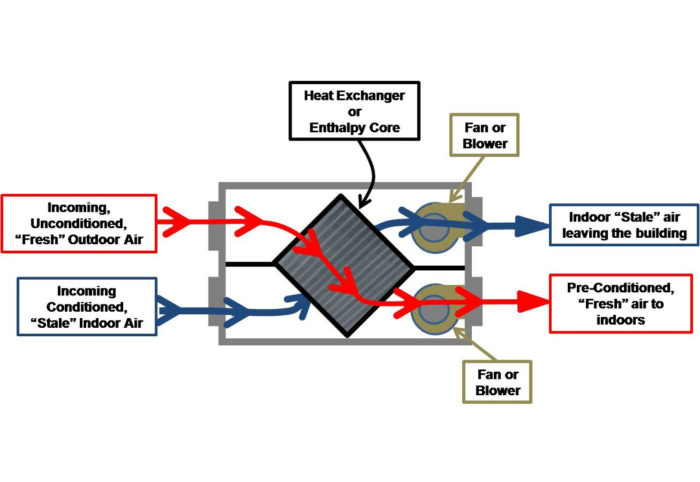Checking out the Perks of Heat Recovery Ventilation for Power Efficiency in Homes
Heat Recovery Ventilation (HRV) systems use house owners a practical method to enhancing energy performance. By reclaiming warmth from outgoing air, these systems can substantially reduce heating & cooling expenses. Furthermore, they give a constant supply of fresh air, boosting indoor air high quality and convenience levels. As property owners take into consideration sustainable choices, comprehending the subtleties of HRV systems comes to be increasingly important. What factors should one assess before making such an investment?
Recognizing Heat Recovery Ventilation Solutions

Exactly How HRV Enhances Indoor Air Top Quality

Energy Cost Savings: The Financial Benefits of HRV
Taking full advantage of energy effectiveness, heat recovery ventilation (HRV) systems supply substantial economic benefits for property owners. By recouping and reusing warmth from exhaust air, HRVs considerably lower cooling and heating costs. This modern technology can result in energy savings of up to 30%, depending on environment and use patterns. Home owners typically observe lowered energy expenses shortly after installment, making HRVs an economically wise investment over time. Furthermore, lots of regions supply incentives or rebates for energy-efficient upgrades, better improving the economic appeal. As energy rates remain to increase, the cost-effectiveness of HRVs comes to be significantly clear. Overall, the incorporation of HRV systems not only advertises energy performance but also adds to long-lasting financial cost savings for homes.
The Ecological Impact of Heat Recovery Ventilation
A substantial ecological benefit of heat recovery ventilation (HRV) systems exists in their ability to reduce overall power intake. By reclaiming warmth from exhaust air and transferring it to inbound fresh air, HRV systems reduce the need for visite site energy-intensive home heating and great site cooling down approaches. This reduction in energy need adds to reduce greenhouse gas exhausts, as less nonrenewable fuel source is needed to preserve comfy indoor temperature levels. In addition, HRV systems improve interior air quality by successfully exchanging stagnant air with fresh outside air, lowering reliance on mechanical air conditioning systems that can damage the atmosphere. On the whole, the execution of HRV systems supports lasting living methods and straightens with global initiatives to combat environment adjustment by promoting power performance in domestic setups.
Choosing the Right HRV System for Your Home
Just how can property owners guarantee they choose the ideal heat recovery ventilation (HRV) system for their needs? They should examine their home's size and layout, as these variables affect air movement demands. Next, assessing the system's efficiency rankings is essential, as higher rankings indicate far better performance and energy cost savings. Home owners should additionally take into consideration setup and maintenance expenses, comparing different brand names and models for worth. Furthermore, it is essential to examine sound levels, as some systems operate more silently than others. Consulting with cooling and heating professionals can provide tailored referrals based on details home conditions. Taking a look at individual testimonials and service warranties can aid in making a notified choice, making certain that the picked HRV system properly boosts interior air high quality and power efficiency.
Often Asked Questions

Just how Usually Should I Tidy or Preserve My HRV System?
The regularity of cleaning or preserving a warm recuperation air flow (HRV) system generally depends upon use and ecological elements. Generally, it is advisable to execute maintenance every six months to ensure peak efficiency and air top quality.

Can HRV Systems Aid Minimize Moisture Degrees Inside?
HRV systems can properly minimize interior humidity degrees by exchanging stale, humid air with fresh, drier air from outdoors. HRV Heat Recovery Ventilation. This process assists keep a balanced interior atmosphere, boosting convenience and avoiding moisture-related problems
What Is the Life-span of a Regular HRV System?
The lifespan of a typical heat recovery ventilation (HRV) system differs, generally lasting between 10 to 15 years. Normal maintenance can expand its performance and functional life, guaranteeing peak performance throughout its use period.
Are There Any Noise Interest In HRV Systems?
Sound worry about HRV systems can emerge, especially from fan procedure. Many contemporary devices are made to lessen sound levels, guaranteeing they run quietly while maintaining efficiency, which resolves potential disturbances in living atmospheres.
Can I Mount an HRV System Myself, or Do I Required a Professional?
The private contemplated whether to mount the heat recovery ventilation (HRV) system directly or hire a specialist. Normally, while DIY setup is click now possible, proficiency guarantees proper functionality and compliance with regional building regulations, boosting system efficiency.